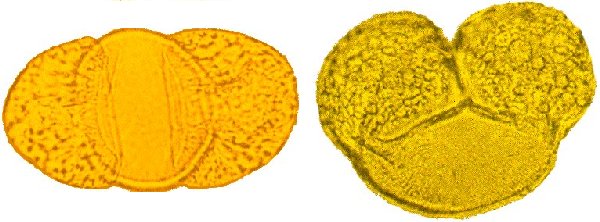Bisaccate grains

The pollen of coniferous trees such as pine, podocarpus and spruce produce a most interesting pollen grain consisting of a single central body with two attached bladders. Because of the resemblance of this structure to a popular Disney character, they are sometimes referred to as "Mickey Mouse" grains. The pollen is produced by coniferous trees in such prolific quantities during the pollenation season, that the ground and nearby bodies of water may be colored golden yellow by the presence of the grains. Pollination of coniferous trees is dependent on the spreading of these grains by wind. The bladders are designed to enable the grains to travel long distances in the air.
The grains shown above include a podocarpus pollen on the left and a grain from pine on the right. Bisaccate grains range from Devonian to Recent in the fossil record.

The pollen of coniferous trees such as pine, podocarpus and spruce produce a most interesting pollen grain consisting of a single central body with two attached bladders. Because of the resemblance of this structure to a popular Disney character, they are sometimes referred to as "Mickey Mouse" grains. The pollen is produced by coniferous trees in such prolific quantities during the pollenation season, that the ground and nearby bodies of water may be colored golden yellow by the presence of the grains. Pollination of coniferous trees is dependent on the spreading of these grains by wind. The bladders are designed to enable the grains to travel long distances in the air.
The grains shown above include a podocarpus pollen on the left and a grain from pine on the right. Bisaccate grains range from Devonian to Recent in the fossil record.
